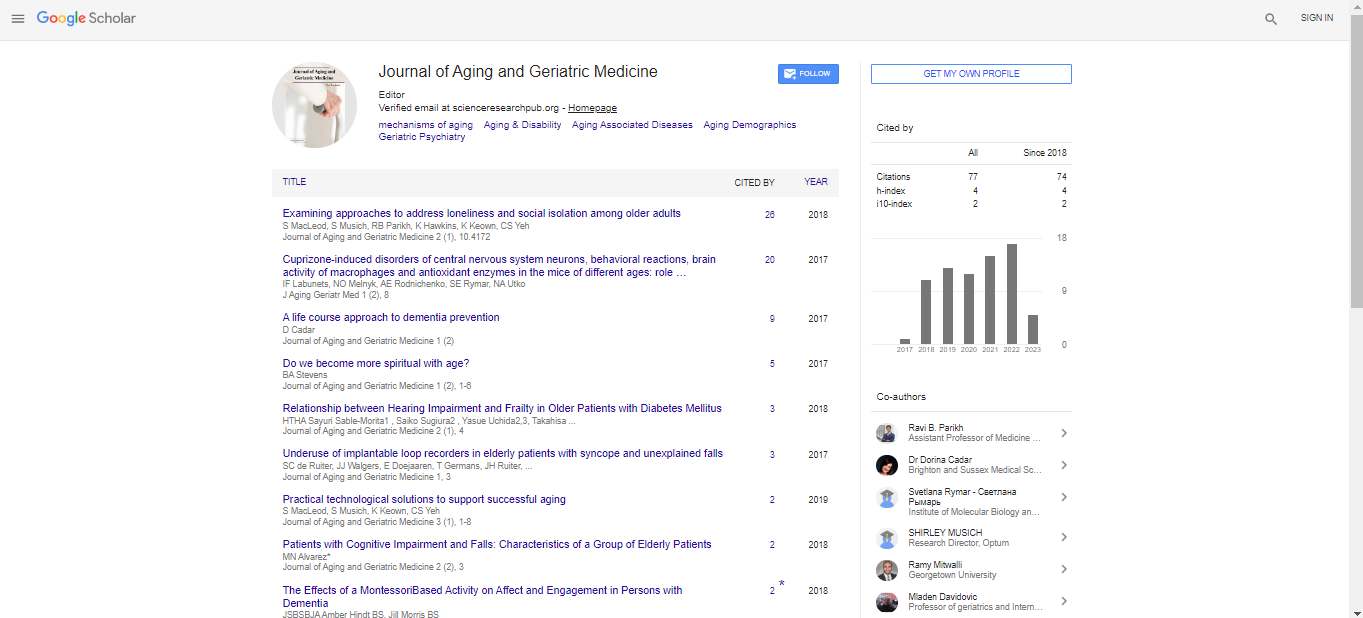Commentary, J Aging Geriatr Med Vol: 7 Issue: 4
Molecular Insights into the Aging Process: Mechanisms and Implications
Sheriff Jade*
1Department of Materials Science and Engineering, University of Washington, Seattle, United States of America
*Corresponding Author: Sheriff Jade,
Department of Materials Science and
Engineering, University of Washington, Seattle, United States of America
E-mail: sheriff987jd@u.washington.edu
Received date: 28 June, 2023, Manuscript No. AGM-23-113038;
Editor assigned date: 30 June, 2023, PreQC No. AGM-23-113038 (PQ);
Reviewed date: 14 July, 2023, QC No. AGM-23-113038;
Revised date: 21 July, 2023, Manuscript No. AGM-23-113038 (R);
Published date: 28 July, 2023, DOI: 10.4172/2576-3946.1000174
Citation: Jade S (2023) Molecular Insights into the Aging Process: Mechanisms and Implications. J Aging Geriatr Med 7:4.
Description
Aging is a complex and multifaceted biological process that leads to a decline in cellular and organismal functions over time. Extensive research has been conducted to uncover the underlying mechanisms driving the aging process, with a focus on molecular and cellular changes that occur as individuals grow older. We also discuss the implications of this knowledge for developing interventions that target aging-related diseases and extend health span. The precise causes of aging remain debated, multiple theories have been proposed to elucidate the molecular basis of this process. The accumulation of cellular damage, telomere shortening, epigenetic changes, and altered nutrient-sensing pathways are some of the key mechanisms associated with aging. Understanding these processes is crucial for developing strategies to mitigate the effects of aging and improve human health.
Among these factors, nutrition plays a crucial role in determining the rate of aging and the development of age-related diseases. We delve into the mechanisms through which different dietary strategies, such as caloric restriction, intermittent fasting, and specific nutrient manipulations, can promote health span extension and mitigate ageassociated decline. The global increase in life expectancy has spurred interest in strategies that extend healthspan, the period of life spent in good health. Nutrition is a modifiable factor that has been extensively studied for its role in influencing aging and age-related diseases. Caloric intake, macronutrient composition, and timing of food consumption all impact cellular processes and metabolic pathways that are intricately linked to aging.
Personalized approaches to aging and nutrition: Individual responses to dietary interventions can vary due to genetic, metabolic, and microbiome differences. Personalized nutrition approaches, informed by omics technologies and health assessments, hold promise in tailoring dietary recommendations to maximize health span for each individual. Nutrients with antioxidant properties, such as vitamins C and E, help combat oxidative stress, a key contributor to aging. These compounds neutralize harmful free radicals and protect cellular components from damage. Resveratrol and other polyphenols activate sirtuins, a family of proteins associated with longevity. They regulate cellular responses to stress and modulate pathways involved in aging.Omega-3 fatty acids, found in fatty fish and flaxseeds, exert antiinflammatory effects and support brain health, potentially delaying cognitive decline.
Impact of nutrient sensing pathways
Caloric Restriction (CR): Caloric restriction involves reducing caloric intake without malnutrition. CR has been shown to extend lifespan and improve healthspan in various organisms. It activates nutrient-sensing pathways such as MTOR (Mechanistic Target of Rapamycin) and AMPK (Adenosine Monophosphate-Activated Protein Kinase), leading to improved cellular maintenance and stress resistance.
Intermittent Fasting (IF): IF cycles between periods of fasting and eating. This dietary strategy enhances autophagy, a cellular recycling process, and triggers metabolic shifts that promote cellular health and longevity.
Molecular Mechanisms of Aging
Cellular senescence: Cellular senescence is characterized by a state of irreversible growth arrest in response to various stressors. Senescent cells accumulate with age and secrete a mixture of pro-inflammatory molecules, contributing to chronic inflammation, tissue dysfunction, and the aging process.
Genomic instability: DNA damage accumulates over time due to various factors, including exposure to environmental stressors and errors during DNA replication. This damage can lead to mutations, genomic rearrangements, and ultimately, cellular dysfunction.
Telomere shortening: Telomeres, protective caps at the ends of chromosomes, shorten with each cell division. Eventually, critically short telomeres trigger cellular senescence or apoptosis, limiting cell proliferation and tissue regeneration.
Epigenetic changes: Epigenetic modifications play a pivotal role in regulating gene expression patterns. With age, the epigenome undergoes alterations, leading to changes in gene expression that contribute to aging-related phenotypes.
Mitochondrial dysfunction: Mitochondria, the cell's energy powerhouses, experience functional decline with age. Accumulation of mitochondrial DNA mutations, oxidative stress, and impaired energy production contribute to cellular dysfunction and aging.
Implications and future directions
Understanding the molecular mechanisms of aging opens up new avenues for interventions that could potentially extend healthspan and delay the onset of age-related diseases. Strategies such as senolytic therapies, which target and eliminate senescent cells, show promise in promoting tissue regeneration and reducing inflammation. Additionally, interventions that maintain telomere length, preserve mitochondrial function, or modulate epigenetic marks are being explored as potential anti-aging strategies
Conclusion
In conclusion, the molecular basis of aging involves intricate and interconnected mechanisms that impact cellular function and contribute to the aging phenotype. Advances in our understanding of these mechanisms offer promising opportunities for developing interventions that target the aging process and improve overall health span. Continued research into the molecular underpinnings of aging will pave the way for innovative therapies aimed at enhancing the quality of life for an aging global population. With various dietary strategies impacting cellular processes and metabolic pathways that influence longevity. Caloric restriction, intermittent fasting, and the strategic inclusion of specific nutrients showcase potential for promoting healthy aging. Continued research in this area will deepen our understanding of the underlying mechanisms, paving the way for innovative dietary interventions that support healthy aging.
 Spanish
Spanish  Chinese
Chinese  Russian
Russian  German
German  French
French  Japanese
Japanese  Portuguese
Portuguese  Hindi
Hindi 